Linux下如何在数据链路层接收原始数据包
文章目录
大多数的网络编程都是在应用层接收数据和发送数据的,程序员无需关注报文的各种报头,网络协议栈会解决这些问题,本文介绍在数据链路层的网络编程方法,介绍如何在数据链路层直接接收从物理层发过来的原始数据包,要得到数据,必须自己解开数据链路层、网络层和传输层的报头,文章给出了一个完整的范例程序,希望本文能帮助读者对网络通信有更深刻的理解;阅读本文需要具备基本的使用socket进行网络编程的能力,熟悉OSI的网络模型,本文对初学者有一定的难度。
1. 概述
- linux下进行网络编程通常都是使用socket在应用层接收和发送数据;
- 本文介绍如何绕过数据链路层、网络层和传输层对数据包的处理,直接从数据链路层接收从物理层发过来的原始数据;
- 本文所介绍的内容在实际编程中很少会用到,但希望对读者理解网络结构和协议能有帮助;
- 本文会提供了直接从数据链路层接收数据的范例程序,源代码在ubuntu 20.04下编译运行成功;
- 本文可能并不适合初学者,但并不妨碍初学者收藏此文,以便在今后学习。
2. socket编程
-
在看下面的内容之前还是要简单地回顾一下TCP/IP的五层网络模型(OSI 七层架构的简化版)
- 应用层
- 传输层
- 网络层
- 数据链路层
- 物理层
-
使用socket进行网络编程时,我们通常只需要关心需要发送的数据,数据发送后,要发送的数据将从应用层向下传递
- 在TCP/UDP(传输)层加入一个TCP头
- 在IP(网络)层加上一个IP头
- 在数据链路层加上一个以太网头
- 交给物理层传输
-
当我们在应用层进行socket编程时,我们通常会这样发送数据(以UDP为例):
1 2 3 4 5 6 7 8 9 10...... struct sockaddr_in addr; int sock = socket(AF_INET, SOCK_DGRAM, 0); ...... addr.sin_family = AF_INET; addr.sin_addr.s_addr = inet_addr(DST_IP); // 目的IP addr.sin_port = htons(PORT); // 端口号 ..... sendto(sock, &DATA, DATA_LEN, 0, (struct sockaddr *)&addr, sizeof(struct sockaddr_in)); close(fd); -
当我们把DATA给sendto(……)以后,会发生什么呢?
- 数据从应用层被送到传输层,传输层给这个数据加上一个UDP 头;
- (UDP头+DATA)从传输层被送到网络层,IP协议会给数据包再加上一个IP头;
- (IP头+UDP头+DATA)从网络层被送到了数据链路层,数据链路层的以太网协议会给这个数据包加上一个以太网头;
- (以太网头+IP头+UDP头+DATA)从数据链路层被送到了物理层,数据就被发送走了。
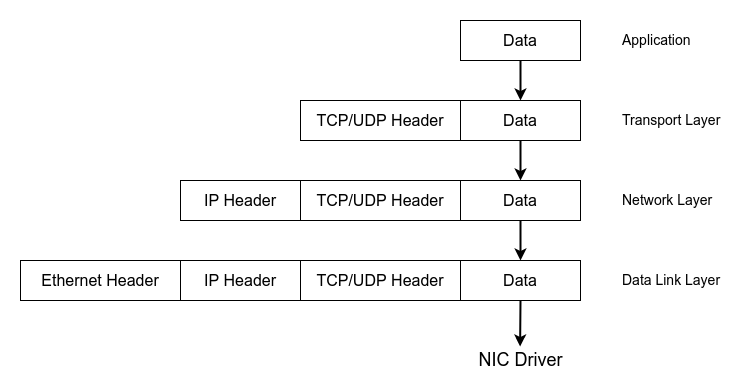
图1:使用socket从应用程序发送数据的过程
-
当我们在应用层进行socket编程时,我们通常会这样接收数据(以UDP为例):
1 2 3 4 5 6 7 8 9 10 11...... struct sockaddr_in addr; int addr_len = sizeof(struct sockaddr_in); int sock = socket(AF_INET, SOCK_DGRAM, 0); ...... addr.sin_family = AF_INET; addr.sin_port = htons(PORT); addr.sin_addr.s_addr = inet_addr(SERVER_IP); ...... recvfrom(sock, buffer, sizeof(buffer), 0, &addr, &addr_len); ...... -
当我们调用recvfrom()函数并成功返回时,都发生了什么事情呢?
- 原始数据包(以太网头+IP头+UDP头+DATA)通过网卡驱动程序发送到数据链路层;
- 数据链路层从原始数据包中提取出以太网头,数据包的其余部分发送给网络层(IP头+UDP头+DATA);
- 网络层从数据中提取出IP头,其余部分交给传输层(UDP头+DATA);
- 传输层从数据中提取出UDP头,其余部分交给应用程序(DATA);
- 所以我们在应用层收到的就只有数据了,报头已经被各协议层提取出来
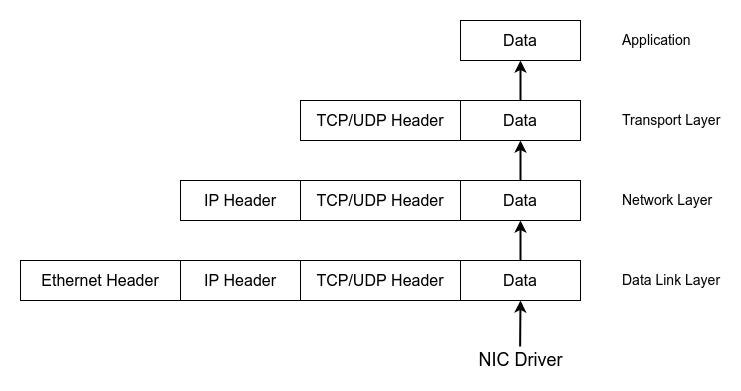
图2:在应用程序中用socket接收数据的过程
- 很显然,在应用层进行网络编程,我们不需要关心各协议层的报头,各层的协议栈会为我们处理好所有报头;
- 但这样的编程显然也是受限的,除了TCP和UDP以外,你还知道有什么其它的网络通信形式吗?这种在应用层的编程仅能收到发给这台机器的数据,而且在你收到的数据中,并没有源和目的地址的任何信息。
- 从图1和图2可以看出,当我们需要在传输层编程时,实际上就是比在应用层编程多了一个UDP(TCP)头;同理,当我们需要在网络层编程时,也就是比在传输层编程多加一个IP头;
- 本文介绍在数据链路层编程,与在应用层的网络编程相比,只是要多封装(提取)三个数据头:以太网头、IP头、UDP(TCP)头
3. raw socket
-
raw socket也是一种socket,常用于接收原始数据包,所谓原始数据包指的是从物理层直接传送出来的数据包;使用raw socket可以绕过通常的TCP/IP处理流程,在应用程序中直接收到原始数据包(见图3)。使用raw socket编程,并不需要对Linux内核有深入的了解。
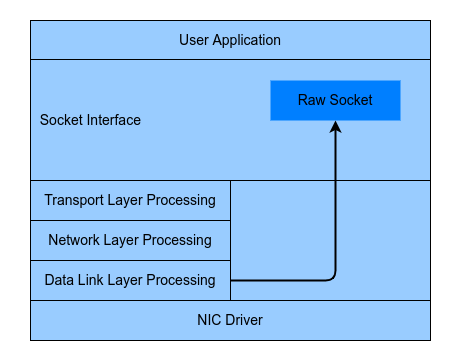
图3:在应用程序中使用raw socket接收数据
- 打开raw socket
-
和普通socket一样,打开一个raw socket,必须要知道三件事:socket family、socket type 和 protocol;
-
对raw socket而言,socket family为AF_PACKET,socket type为SOCK_RAW;
-
接收数据时,protocol请参考头文件if_ether.h;接收所有数据包,protocol使用宏ETH_P_ALL;接收IP数据包,protocol使用宏ETH_P_IP。
1 2 3 4 5 6int sock_raw; sock_raw = socket(AF_PACKET, SOCK_RAW, htons(ETH_P_ALL)); if (sock_raw < 0) { printf("error in socket\n"); return -1; } -
发送数据时,protocol要参考头文件in.h,通常protocol使用IPPROTO_RAW;
1 2 3sock_raw = socket(AF_PACKET, SOCK_RAW, IPPROTO_RAW); if (sock_raw == -1) printf("error in socket");
-
4. 数据报的报头
-
前面提过,应用程序使用socket发送数据(以UDP为例)的时候,在经过传输层时,要增加一个UDP头,经过网络层时,要再加上一个IP头,在经过数据链路层时,还要加上一个以太网头,然后才能交给物理层发送,见图1;
-
同样,应用程序使用socket接收数据(以UDP为例)时,数据从物理层经过数据链路层时,将去除以太网头,在经过网络层时,要去掉IP头,在经过传输层时,还要去掉UDP头,所以到达应用程序时,就只有数据了,见图2;
-
当使用raw_socket在数据链路层编程时,收到的数据需要自行解开以太网头、IP头、UDP头;而发送数据时,需要自行在数据上封装UDP头、IP头和以太网头;
-
网络报文的报头的通用定义
- 网络报文的报头分为三个部分:传输层的传输层协议头、网络层的网络层协议头和数据链路层的以太网头,见图4;

图4:网络报头的通用定义
- 以下仅就本文范例中用到的报头结构做一个简单说明。
-
数据链路层的以太网头
- 以太网报头定义在头文件linux/if_ether.h中:
1 2 3 4 5struct ethhdr { unsigned char h_dest[ETH_ALEN]; /* destination eth addr */ unsigned char h_source[ETH_ALEN]; /* source ether addr */ __be16 h_proto; /* packet type ID field */ } __attribute__((packed)); - h_dest字段为目的MAC地址,h_source字段为源MAC地址;
- h_proto表示当前数据包在网络层使用的协议,Linux支持的协议在头文件linux/if_ether.h中定义;通常在网络层使用的IP协议,这个字段的值是0x0800(ETH_P_IP);
- 以太网报头定义在头文件linux/if_ether.h中:
-
网络层的 IP 头
-
IP(Internet Protocol)协议是网络层最常用的协议;
-
IP报头定义在头文件linux/ip.h中;
1 2 3 4 5 6 7 8 9 10 11 12 13 14 15 16 17 18 19 20 21struct iphdr { #if defined(__LITTLE_ENDIAN_BITFIELD) __u8 ihl:4, version:4; #elif defined (__BIG_ENDIAN_BITFIELD) __u8 version:4, ihl:4; #else #error "Please fix <asm/byteorder.h>" #endif __u8 tos; __be16 tot_len; __be16 id; __be16 frag_off; __u8 ttl; __u8 protocol; __sum16 check; __be32 saddr; __be32 daddr; /*The options start here. */ };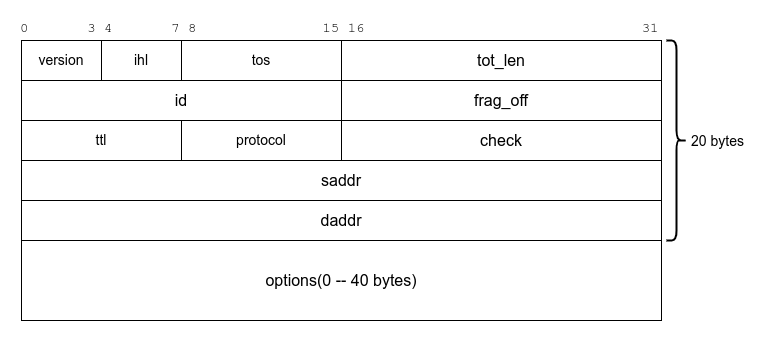
图5:IP 报头
- version - IPV4时,version=4
- ihl(Internet Header Length) - 报头的长度,表示报头占用多少个32 bits字(4 字节),IP报头最少要20 bytes,也就是ihl=5,最长可以是60 bytes,也就是ihl=15;ihl x 4就是IP报头占用的字节数;
- tos - 这个字段通常并不使用,可以填0;
- tot_len(Total Length) - 报文全长,包括IP头和IP payload,单位是字节;
- id - IP报文的唯一标识,同一个IP报文分片传输时,其id是一样的,便于分片重组;
- frag_off(Fragment Offest) - 其中bit 0、bit 1 和 bit 2用于控制和识别分片,bit 3 - 15这13个bit表示每个分片相对于原始报文开头的偏移量,以8字节作单位;
- ttl(Time To Live) - 这个字段是为了防止报文在互联网上永远存在(比如进入路由环路),在发送报文时设置这个值,最大255,通常设置为64,每经过一个路由器,该值将减1,当为0时,该报文将被丢弃;
- protocol - 该字段定义了在传输层所用的协议,协议号列表文件在/etc/protocols文件中,UDP为17,TCP为6,其取值定义在头文件linux/in.h中;
- check - IP头的检查和,不包括payload,关于IP头的检查和的计算方法有专门的文章介绍,开一参考这里,也可以参考本文的范例源代码;
- saddr - 源IP地址,此字段是一个4字节的IP地址转为二进制并拼在一起所得到的32位值;例如:10.9.8.7是00001010 00001001 00001000 00000111
- daddr - 目的IP地址,表示方法与saddr一样;
- 当数据链路层的h_proto字段为ETH_P_IP时,表示网络层使用的是IP(Internet Protocol)协议;实际上,网络层支持一些其它的协议,比如:Ethernet Loopback、Xerox PUP等;
- 网络层和传输层支持的协议可以在文件/etc/protocols中查看。
-
-
传输层的 UDP 头
- UDP(User Datagram Protocol)是传输层最常用的协议之一;
- UDP头定义在头文件linux/udp.h中;
1 2 3 4 5 6struct udphdr { __be16 source; __be16 dest; __be16 len; __sum16 check; }; - source - 来源连接端口号,可选项,如果不使用,填充0;
- dest - 目的连接端口号;
- len - 报文长度;
- check - 报头的校验和,在IPv4中是可选的,IPv6中是强制的,如果不使用,应填充0;校验和的计算还涉及到UDP的伪头部,请参考相关文章;
5. 使用 raw socket 接收数据
-
把上面介绍的内容综合起来就可以编写出一个在数据链路层使用raw socket接收原始数据包的程序了;
-
以接收一个UDP数据包为例说明接收数据的步骤:
- 打开一个raw socket;
- 在内存中分配一个buffer,并接收数据;
- 提取数据链路层的以太网协议头;
- 提取解开网络层的IP协议头;
- 提取解开传输层的UDP协议头;
- 提取收到的数据
-
下面是一个监听UDP数据包的范例程序,文件名receive_udp_packet.c
1 2 3 4 5 6 7 8 9 10 11 12 13 14 15 16 17 18 19 20 21 22 23 24 25 26 27 28 29 30 31 32 33 34 35 36 37 38 39 40 41 42 43 44 45 46 47 48 49 50 51 52 53 54 55 56 57 58 59 60 61 62 63 64 65 66 67 68 69 70 71 72 73 74 75 76 77 78 79 80 81 82 83 84 85 86 87 88 89 90 91 92 93 94 95 96 97 98 99 100 101 102 103 104 105 106 107 108 109 110 111 112 113 114 115 116 117 118 119 120 121 122 123 124 125 126 127 128 129 130 131 132 133 134 135 136 137 138 139 140 141 142 143 144 145 146 147 148 149 150 151 152 153 154 155 156 157 158 159 160 161 162 163 164 165 166 167 168 169 170 171 172 173 174 175 176 177 178 179 180 181 182 183 184 185 186 187 188 189 190 191 192 193 194 195 196 197 198 199 200 201 202 203 204 205 206 207 208 209 210 211 212 213 214 215 216 217 218 219 220 221 222 223 224 225 226 227 228 229 230 231#include <stdio.h> #include <unistd.h> #include <string.h> #include <signal.h> #include <malloc.h> #include <sys/socket.h> #include <sys/types.h> #include <arpa/inet.h> // to avoid warning at inet_ntoa #include<linux/if_packet.h> #include <linux/in.h> #include <linux/if_ether.h> #include <linux/ip.h> #include <linux/udp.h> #include <linux/tcp.h> #define LOG_FILE "udp_packets.log" // log file name struct ethhdr *eth_hdr; struct iphdr *ip_hdr; struct udphdr *udp_hdr; /***************************************************************************** * Function: unsigned int ethernet_header(unsigned char *buffer, int buflen) * Description: Extracting the Ethernet header * struct ethhdr is defined in if_ether.h * * Entry: buffer data packet * buf_len length of data packet * Return: protocol of network layer or -1 when error *****************************************************************************/ int ethernet_header(unsigned char *buffer, int buf_len) { if (buf_len < sizeof(struct ethhdr)) { printf("Wrong data packet.\n"); return -1; } eth_hdr = (struct ethhdr *)(buffer); return ntohs(eth_hdr->h_proto); } /********************************************************************************* * Function: void log_ethernet_header(FILE *log_file, struct ethhdr *eth_hdr) * Description: write ether header into log file * * Entry: log_file log file object * eth_hdr pointer of ethernet header structure *********************************************************************************/ void log_ethernet_header(FILE *log_file, struct ethhdr *eth_hdr) { fprintf(log_file, "\nEthernet Header\n"); fprintf(log_file, "\t|-Source MAC Address : %.2X-%.2X-%.2X-%.2X-%.2X-%.2X\n", eth_hdr->h_source[0], eth_hdr->h_source[1], eth_hdr->h_source[2], eth_hdr->h_source[3], eth_hdr->h_source[4], eth_hdr->h_source[5]); fprintf(log_file, "\t|-Destination MAC Address: %.2X-%.2X-%.2X-%.2X-%.2X-%.2X\n", eth_hdr->h_dest[0], eth_hdr->h_dest[1], eth_hdr->h_dest[2], eth_hdr->h_dest[3], eth_hdr->h_dest[4], eth_hdr->h_dest[5]); fprintf(log_file, "\t|-Protocol : 0X%04X\n", ntohs(eth_hdr->h_proto)); // ETH_P_IP = 0x0800, ETH_P_LOOP = 0X0060 } /******************************************************************************** * Function: unsigned int ip_header(unsigned char *buffer, int buf_len) * Description: Extracting the IP header * struct iphdr is defined in ip.h * * Entry: buffer data packet * buf_len length of data packet * return: protocol of transport layer or -1 when error ********************************************************************************/ int ip_header(unsigned char *buffer, int buf_len) { if (buf_len < sizeof(struct ethhdr) + 20) { printf("Wrong data packet.\n"); return -1; } ip_hdr = (struct iphdr *)(buffer + sizeof(struct ethhdr)); int tot_len = ntohs(ip_hdr->tot_len); if (buf_len < sizeof(struct ethhdr) + tot_len) { printf("Wrong data packet.\n"); return -1; } return (int)ip_hdr->protocol; } /******************************************************************************** * Function: void log_ip_header(FILE *log_file, struct iphdr *ip_hdr) * Description: write ip header into log file * * Entry: log_file log file's handler * ip_hdr the pointer of ip header structure ********************************************************************************/ void log_ip_header(FILE *log_file, struct iphdr *ip_hdr) { struct sockaddr_in source, dest; memset(&source, 0, sizeof(source)); source.sin_addr.s_addr = ip_hdr->saddr; memset(&dest, 0, sizeof(dest)); dest.sin_addr.s_addr = ip_hdr->daddr; fprintf(log_file, "\nIP Header\n"); fprintf(log_file, "\t|-Version : %d\n", (unsigned int)ip_hdr->version); fprintf(log_file, "\t|-Internet Header Length: %d DWORDS or %d Bytes\n", (unsigned int)ip_hdr->ihl, ((unsigned int)(ip_hdr->ihl)) * 4); fprintf(log_file, "\t|-Type Of Service : %d\n", (unsigned int)ip_hdr->tos); fprintf(log_file, "\t|-Total Length : %d Bytes\n", ntohs(ip_hdr->tot_len)); fprintf(log_file, "\t|-Identification : %d\n", ntohs(ip_hdr->id)); fprintf(log_file, "\t|-Time To Live : %d\n", (unsigned int)ip_hdr->ttl); fprintf(log_file, "\t|-Protocol : %d\n", (unsigned char)ip_hdr->protocol); fprintf(log_file, "\t|-Header Checksum : %d\n", ntohs(ip_hdr->check)); fprintf(log_file, "\t|-Source IP : %s\n", inet_ntoa(source.sin_addr)); fprintf(log_file, "\t|-Destination IP : %s\n", inet_ntoa(dest.sin_addr)); } /************************************************************************ * Function: udp_header(FILE *log_file, struct iphdr *ip_hdr) * Description: Extracting the UDP header * * Entry: log_file log file * ip_hdr pointer of IP header ************************************************************************/ void udp_header(FILE *log_file, struct iphdr *ip_hdr) { fprintf(log_file, "\nUDP Header\n"); udp_hdr = (struct udphdr *)((unsigned char *)ip_hdr + (unsigned int)ip_hdr->ihl * 4); fprintf(log_file, "\t|-Source Port : %d\n", ntohs(udp_hdr->source)); fprintf(log_file, "\t|-Destination Port: %d\n", ntohs(udp_hdr->dest)); fprintf(log_file, "\t|-UDP Length : %d\n", ntohs(udp_hdr->len)); fprintf(log_file, "\t|-UDP Checksum : %d\n", ntohs(udp_hdr->check)); } /************************************************************************** * Function: void udp_payload(FILE *log_file, struct udphdr *udp_hdr) * Description: Show data * * Entry: buffer data packet * buf_len length of data packet **************************************************************************/ void udp_payload(FILE *log_file, struct udphdr *udp_hdr) { int i = 0; unsigned char *data = (unsigned char *)udp_hdr + sizeof(struct udphdr); fprintf(log_file, "\nData\n"); int data_len = ntohs(udp_hdr->len) - sizeof(struct udphdr); for (i = 0; i < data_len; i++) { if (i != 0 && i % 16 == 0) fprintf(log_file, "\n"); fprintf(log_file, " %.2X ", data[i]); } fprintf(log_file, "\n"); } /***************************************************** * Main *****************************************************/ int main() { FILE* log_file; // log file struct sockaddr saddr; int sock_raw, saddr_len, buf_len; int ret_value = 0; int done = 0; // exit loop when done=1 int udp = 0; // udp packet count // open a raw socket sock_raw = socket(AF_PACKET, SOCK_RAW, htons(ETH_P_ALL)); if (sock_raw < 0) { printf("Error in socket\n"); return -1; } // Allocate a block of memory for the receive buffer unsigned char *buffer = (unsigned char *)malloc(65536); if (buffer == NULL) { printf("Unable to allocate memory.\n"); close(sock_raw); return -1; } memset(buffer, 0, 65536); // Create a log file for storing output log_file = fopen(LOG_FILE, "w"); if (!log_file) { printf("Unable to open %s\n", LOG_FILE); free(buffer); close(sock_raw); return -1; } printf("starting .... %d\n", sock_raw); while (!done) { // Receive data packet saddr_len = sizeof saddr; buf_len = recvfrom(sock_raw, buffer, 65536, 0, &saddr, (socklen_t *)&saddr_len); if (buf_len < 0) { printf("Error in reading recvfrom function\n"); ret_value = -1; goto QUIT; } fflush(log_file); // Extracting the Ethernet header if (ethernet_header(buffer, buf_len) != ETH_P_IP) { // drop the packet if network layer protocol is not IP continue; } // Extracting the IP header if (ip_header(buffer, buf_len) != 17) { // drop packet if transport layer protocol is not UDP continue; } fprintf(log_file, "\n**** UDP packet %02d*********************************\n", udp + 1); // Write ethernet header into log file log_ethernet_header(log_file, eth_hdr); // Write IP header into log file log_ip_header(log_file, ip_hdr); // Extracting the UDP header and write into log file udp_header(log_file, ip_hdr); // write UDP payload into log file udp_payload(log_file, udp_hdr); // exit when the count of received udp packets is more than 10 if (++udp >= 10) done = 1; } QUIT: fclose(log_file); free(buffer); close(sock_raw); // close raw socket printf("DONE!!!!\n"); return ret_value; } -
该程序使用raw_socket在数据链路层直接接收从物理层发过来的数据,数据不会经过各个协议层的处理;
-
在应用层进行socket进行网络编程时,端口号可以用于区分接收数据的应用程序,使用raw socket接收数据时,端口号没有用;
-
该程序将收到的udp数据包的以太网头、IP头、UDP头提取出来,和数据一起写入到文件udp_packets.log文件中;
-
该程序丢弃了除UDP包以外的所有其它数据包;
-
为了避免冗长的log文件,这个程序接收10个UDP数据包后会自动退出;
-
该程序经过扩展后可以成为一个简单的数据包嗅探器;
-
编译程序
1gcc -Wall receive_udp_packet.c -o receive_udp_packet -
运行程序
1sudo ./receive_udp_packet- 这个程序必须要使用root权限运行,因为使用了raw socket
-
测试程序
-
最好使用局域网中的两台机器(虚拟机)进行测试,因为在下面的测试方法中,从本机发送时,以太网头中的源和目的MAC地址可能会被填0;
-
假定A机的IP地址为 192.168.2.114,在A机运行程序receive_udp_packet程序;
-
我们从B机(与A机的IP不同),发送数据:
1 2 3echo -n "udp packet 01" > /dev/udp/192.168.2.114/8000 echo -n "udp packet 02" > /dev/udp/192.168.2.114/8001 ...... -
8000和8001是端口号,可以是任意的;
-
连接在网络上的A机,有可能会从网络上收到其它的UDP包,所以A机启动receive_udp_packet程序后,要尽快在B机发出数据,否则可能你还没有发出数据,A机已经收到了10条UDP包并自动退出;
-
查看log文件,看看有没有你发出来的数据
1cat udp_packets.log -
在我的电脑上看到的是这样的:
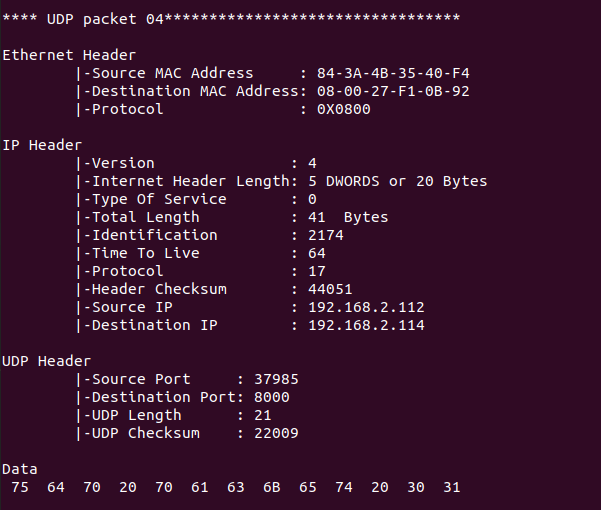
图6:收到的 UDP 数据包
-
欢迎订阅 『网络编程专栏』
欢迎访问我的博客:https://whowin.cn
email: hengch@163.com

文章作者 whowin
上次更新 2022-12-07